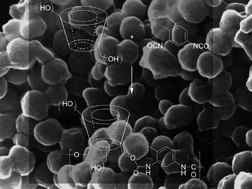Polymeric cyclodextrin-based nanoparticles: synthesis, characterization and sorption properties of three selected pharmaceutically active ingredients
Abstract
The reaction of three

* Corresponding authors
a
School of Life Sciences, University of Applied Sciences Northwestern Switzerland, Gründenstrasse 40, Muttenz, Switzerland
E-mail:
patrick.shahgaldian@fhnw.ch
b Envolure, 2 place Pierre Viala, Montpellier Cedex 2, France
The reaction of three

 Please wait while we load your content...
Something went wrong. Try again?
Please wait while we load your content...
Something went wrong. Try again?
P. Xiao, Y. Dudal, P. F.-X. Corvini and P. Shahgaldian, Polym. Chem., 2011, 2, 120 DOI: 10.1039/C0PY00225A
To request permission to reproduce material from this article, please go to the Copyright Clearance Center request page.
If you are an author contributing to an RSC publication, you do not need to request permission provided correct acknowledgement is given.
If you are the author of this article, you do not need to request permission to reproduce figures and diagrams provided correct acknowledgement is given. If you want to reproduce the whole article in a third-party publication (excluding your thesis/dissertation for which permission is not required) please go to the Copyright Clearance Center request page.
Read more about how to correctly acknowledge RSC content.
 Fetching data from CrossRef.
Fetching data from CrossRef.
This may take some time to load.
Loading related content
